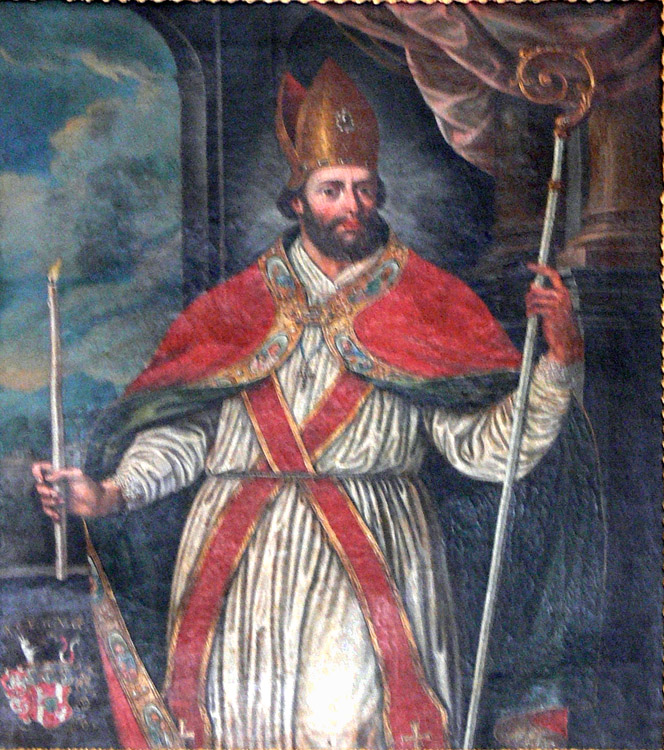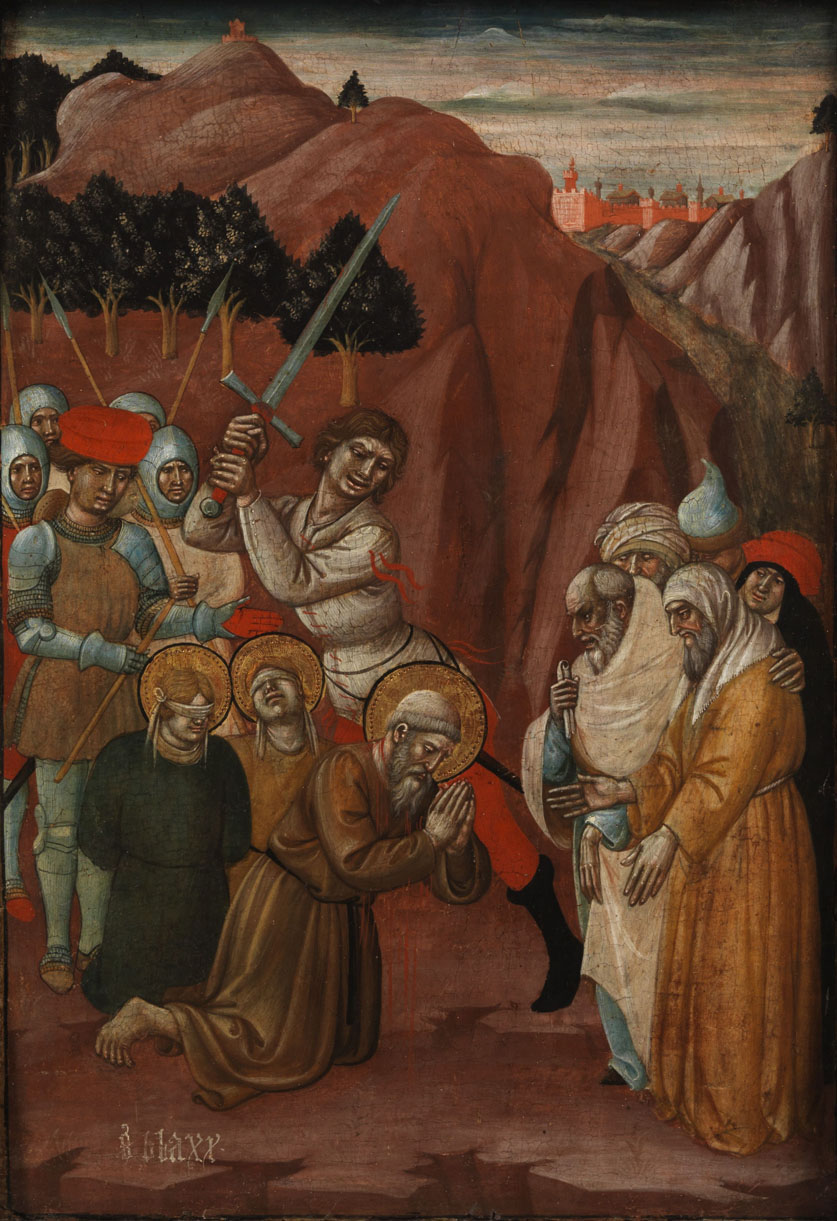PORTRAITS
The saint is always portrayed in episcopal vestments with a bishop's mitre and crozier (example). Images with a martyr's palm are very rare. His martyrdom is more often symbolized, if at all, by an iron comb (example).
The most frequent attribute, especially in later years, is a candle, as in the first picture at right. This refers to a candle that was brought to him in prison, along with some food, by a woman whom he had helped earlier. In the Golden Legend Blaise tells the woman "that every year she should offer in his church a candle, and know thou that to thee and to all them that so shall do shall well [prosperity] happen to them." In Roman Catholic churches the use of candles on Blaise's feast continues to this day.
Some portraits draw on the Blaise legends' Eucharistic imagery. The fourth version in the Acta Sanctorum, for example, has Jesus appear to the saint on the eve of his arrest and tell him to celebrate Mass: "and when you have faithfully taken of the Cup and of my Body, drink that same cup full of true blood." Awakening, Blaise realizes that "the Lord was calling him to . . . his own passion and martyrdom."1 This identification of the Eucharistic cup with the Christian's sacrifice of himself can be traced to Jesus' own words and is particularly emphasized in Roman Catholic doctrine.2
Thus, in a 15th-century fresco a chalice and paten serve as the saint's attribute, and in a 19th-century image we see God's call to Blaise while he is at an altar. Another intriguing example is an 11th-century portable altar that symbolically relates the sacrifice of Isaac to the sacrifice performed on Christian altars by Saints Blaise and Nicholas.
In Dubrovnik, Croatia, the many images of Blaise have him holding a maquette of the city, of which he is the patron saint (examples from the Church of St. Blaise and from one of the city gates).
NARRATIVE IMAGES
These are not as numerous as portraits. The revived boy is among the more common narrative images (example). The beheading is in the second picture at right. In the Golden Legend Blaise makes a wolf return a pig it had stolen from a poor woman. This is illustrated in a 15th-century predella panel by Sano di Pietro.3
Prepared in 2014 by Richard Stracke, Emeritus Professor of English, Augusta University, revised 2015-10-13, 2016-09-29, 2016-10-28.

St. Blaise, 1740 (See the description page.)

Pesaro, The Martyrdom of St. Blaise, 15th century. (See the description page.)
ATTRIBUTES
- Candles
- Iron comb
- Chalice and paten
MORE IMAGES
- Late 16th or early 17th century: In Venice's Church of St. Blaise a pair of iron combs represent the saint by proxy in Palma il Giovane's St. Nicholas altarpiece
- 19th century (?): Statue in the Church of St. Blaise, Glottertal, Germany.
- 19th century (?): Pew backs with the Madonna, Blaise, and Catherine of Alexandria.
DATES
- Blaise died in the 3rd or 4th century.
- His feast day is February 3 in the West and February 11 in the East.
BIOGRAPHY
- Golden Legend #38: html or pdf
- Early South English Legendary, 485-90
- Apollinaris' vita in The Roman Breviary: English translation, I, 743; Latin original, 821-22
- Acta Sanctorum (in Latin), February vol. 1, 331-53
NOTES
1 Acta Sanctorum, February vol. 1, p. 350. Compare the second version, where upon his arrest Blaise says, "Let us hurry then, and may he be with us who has desired the sacrifice [hostiam] of my body, my Lord Jesus Christ" (ibid. 340). In the Golden Legend God appears to him in prison and says "Rise and offer sacrifice to me" (Ryan 151, not in Caxton). In the fourth Acta Blaise also brings the Eucharistic host to St. Eustratius on the morning of the latter's martyrdom (ibid. 349).
2 Catechism of the Catholic Church, 160f and 344 (¶¶ 618 and 1367).
3 The panel illustrating the pig episode is in a predella that One Hundred Saints says is in "Pinacoteca, Siena" (94-95). It is not among the works listed by Siena's Pinacoteca Nazionale; perhaps the city's Cathedral Museum was meant.